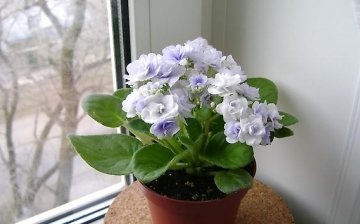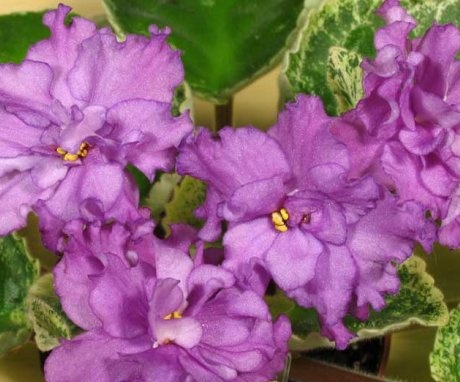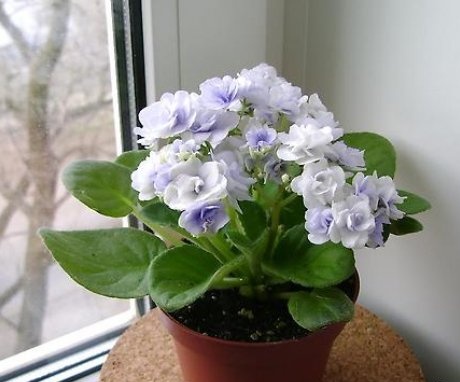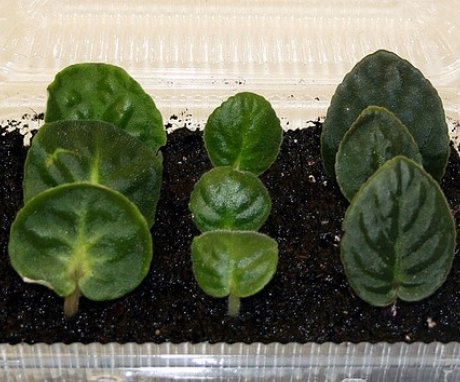Expert advice on the rules of growing and caring for a violet ballerina
Violet ballerina is a rather original houseplant that can decorate any windowsill. In addition, this flower is quite unpretentious to care for, which allows even the laziest housewife to grow it.
Content:
Description of violet ballerina
Violet ballerina refers to indoor plant categories... This is a fairly miniature flower that can decorate any room. This plant is characterized by the presence of highly pointed variegated foliage, which has a dark green color. The rosette of violet leaves is located at the root.
The leaves are oval and grow singly from the rosette.
This plant has erect, bell-shaped flowers. They are pink or purple in color. The core of the flowers is yellow.
Features of care for a violet ballerina
Violet ballerina prefers daylight, but it is not worth placing the plant in places under direct exposure to sunlight, as this can lead to its wilting. It is best to plant violets on the north window.
In the event that the owner cannot place the violet ballerina in a given place, then it must be limited from the effects of the rays with the help of a thick curtain. The ideal option in this case would be tulle, which will limit exposure to sunlight and at the same time provide very good lighting for the violet.
Choosing a pot for violets:
- It is also quite an important point when growing this plant.
- It is best in this case to choose pots made of plastic, in which the ballerina's violet will grow and develop most beneficially.
- For a violet ballerina, a pot with a diameter of no more than 10 centimeters would be an ideal option.
Violet ballerina is best planted in ordinary land.
You can also use centipoly for planting this plant. The pot needs to be filled drainage up to half. Caring for a violet ballerina also requires adhering to proper watering.
Watering violets:
- With insufficient watering, the violet will develop slowly or dry out altogether.
- At the same time, you should also not overdo it with watering, since excessive soil moisture can lead to rotting of the root system of the flower and its death.
- Watering must be done in this way: in a bowl of water, you must place a pot with a violet, at the bottom of which there must be a hole. The violet will saturate its root system with water on its own.
- Fertilizers can be added to a bowl of water, which will ensure more productive flowering of this plant.
Violet ballerina requires regular fertilization. This action must be performed every two weeks. Fertilizers are laid during the flowering period of the violet. Do not overdo it with the amount of fertilizer, otherwise it will negatively affect the growth and development of the flower.
Repotting a violet must be transplanted once a year.
Planting this plant produced in the same pots. When transplanting violets, you just need to replace the soil. Also, the violet requires regular spraying.The best way to do this is to use a water spray at room temperature. You can also wipe the violet leaves with a damp cloth, which will have a beneficial effect on the flowering of this plant. Hygienic cleaning of violets should be done in the bathroom. After cleaning the flower, it should dry in a shaded place. If the flower is placed in the sun, then its rays will harm the violet.
Caring for a violet requires regular performance of the following actions:
- Watering.
- Fertilization.
- Transfer.
- Providing a full-fledged light regime.
If all these actions are carried out in a timely manner, then the violet ballerina will become a real decoration of any room.
Breeding features
Violet ballerina reproduces with the help of leaves.
This requires:
- Take a leaf from a healthy violet. It is placed in a specially prepared pot.
- Before that you need hold a leaf in water, which will significantly speed up the breeding process.
- To do this, you must use dark glass dishes.
- Medicine bottles are ideal in this case.
- Ordinary water is poured into the bottle, which must be diluted with distilled water.
- In order to prevent leaf decay, activated carbon must be added to the water.
- A violet stalk is immersed in water no more than 1 centimeter. The stalk does not need to be replaced with water, but it must be refilled regularly.
- Place dishes with cuttings in a place that is protected from the sun. In the event that the stalk rots, it must be cut obliquely.
- The cut site is covered with activated carbon. After a couple of weeks, roots will appear on the cuttings, which will require planting the plant in the ground.
- For planting the cuttings in the ground you need to take containers with holes in the bottom (for example, plastic cups).
- One third of the container must be filled with a layer of drainage, and then covered with earth to the top.
- The stalk is planted to a depth of one and a half centimeters. A violet leaf must be watered as the soil dries.
- The roots of this leaf will appear within 2-3 weeks after planting.
In order for the violet ballerina not to lose her beauty in the future generation, it is best to propagate it with peduncles or stepsons. For the reproduction of violets by stepchildren, it is necessary to separate the side stepsons, which form in the axils of the violets, from the side outlets. The stepsons take root in the same way as the leaves. After the young rosettes have grown, they must be transplanted into pots with soil.
For the reproduction of violets, a ballerina with peduncles must take a flower from the mother plant that has blossomed or has already faded.
It should have large stipules. You need to cut the flower with a clean knife. Its landing is carried out directly into the ground. If a young rosette has formed near the stipule, then this means that violet rooted.
All of the above methods of breeding violets ballerina are quite effective. Their choice directly depends on the preferences of the person. If you adhere to the rules for transplanting violets, then you can achieve good results. Violet ballerina is a rather unpretentious plant to care for. With proper care, the violet will bloom wildly every year, which can delight the eye of any owner.
More information can be found in the video.














After reading the article, I wanted to grow this beautiful flower on my windowsill. I love violets, but I thought caring for them was more difficult.
I read a lot of special literature about saintpaulias or violets, but nowhere did I come across the definition of "violet ballerina". To be honest, I didn’t understand, "ballerina" is this variety or species? Also "surprised" that the bell-shaped violet flowers, in my opinion, this is an incorrect description.